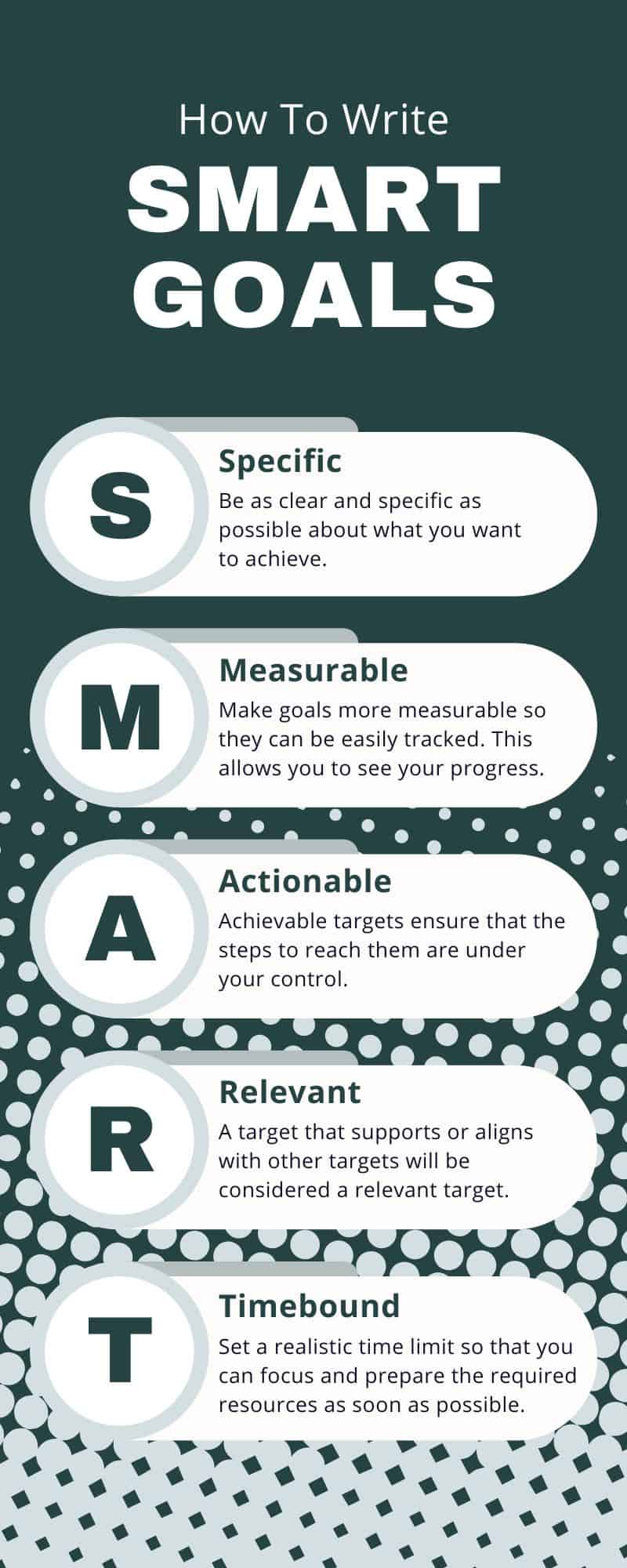A wellness goal is a specific, actionable commitment aimed at improving an area of your health—physical, mental, emotional, or social. These goals are key to building a better quality of life over time.

Jump to:
- What Is a Wellness Goal?
- Why Wellness Goals Matter
- Types of Wellness
- 40+ Example of Wellness Goals
- How to Set Wellness Goals That Work
- Short-Term Wellness Goals (Win the Week)
- Long-Term Wellness Goals (Build the Habit)
- More examples of wellness goals
- What Are Health and Wellness Goals?
- More Ideas for Personal Wellness Goals
- Common Wellness Goal Challenges and Fixes
- Tips for achieving wellness goals
- Wrap-up and conclusion
What Is a Wellness Goal?
A wellness goal is a personal commitment to improve your health and wellbeing through manageable habits and activities.
Why Wellness Goals Matter
Setting goals for wellness gives you structure, keeps you accountable, and supports better choices across daily life. The right wellness goals can:
- Improve sleep quality
- Lower blood pressure and stress
- Stabilize blood sugar levels
- Support healthy weight
- Reduce anxiety
- Improve relationships
These are small efforts that lead to long-term health benefits.
Types of Wellness
Wellness isn’t one-size-fits-all. It shows up in different parts of your life. Here’s a breakdown of the 4 major types of wellness goals, including physical, mental, emotional, and social areas:
| Wellness Type | Focus | Goal Example |
| Physical | Movement, nutrition, rest | Walk 30 mins daily; track blood pressure |
| Mental | Focus, calm, clarity | Cut screen time to under 2 hours |
| Emotional | Mood regulation, stress response | Journal 3 things you're grateful for nightly |
| Social | Community, connection, communication | Join a local walking group |
40+ Example of Wellness Goals

1. Physical wellness
- Walk at least 7,000 steps daily
- Drink 8 glasses of water per day
- Eat a balanced breakfast for 5 days per week
- Reduce added sugar for 30 days
- Limit processed snacks to 1 per day
- Use a blood pressure monitoring watch
- Track weight once per week
- Limit caffeine to 1 cup per day
- Do arm exercises 3x per week
- Schedule an annual wellness visit
Specific objectives of physical wellness goals:
- Increase cardiovascular fitness
- Improve body weight management
- Maintain steady blood sugar levels
2. Mental and Emotional Wellness Goal Examples
- Meditate 10 minutes daily
- Write down stress triggers every night
- Read one book per month
- Set phone limits during meals
- Practice 4-7-8 breathing before sleep
- Start a screen-free hour every evening
- Replace negative self-talk with one positive affirmation daily
- See a therapist once a month
- Practice mindfulness while eating
3. Social Wellness Goal Examples
- Call or text one friend weekly
- Attend two community events each month
- Go on a weekly coffee date with a family member
- Have dinner with your household at least 3 times a week
- Send a hand-written note to someone once a month
- Participate in a group hobby (walking club, book club, etc.)
Specific objectives in social wellness goals:
- Build meaningful connection
- Improve communication habits
- Reduce isolation
4. Personal Wellness Plan Examples
- Develop a consistent morning routine
- Eat more vegetables at lunch daily
- Schedule your yearly checkups in advance
- Plan all weekly meals every Sunday
- Replace soda with water during lunch
- Track sleep patterns for 30 days
- Set a daily “tech break” hour
How to Set Wellness Goals That Work
Use the S.M.A.R.T. format:
| Step | Description |
| Specific | Be exact: "Walk 30 mins" not "exercise more |
| Measurable | Use a planner or app to track progress |
| Achievable | Fit into your current lifestyle |
| Realistic | Avoid goals that are too ambitious |
| Time-based | Set a daily or weekly time frame |
Smart Wellness Goals Examples

Here are real-life smart wellness goals:
- “I’ll drink 8 cups of water daily for 14 days.”
- “I’ll walk 30 minutes per day, 5 days a week.”
- “I’ll limit screen time to 1 hour per night starting next Monday.”
- “I’ll call one friend per week for the next month.”
- “I’ll sleep by 10:30 p.m. every night for 10 days.”
Short-Term Wellness Goals (Win the Week)
| Goal | Timeframe |
| Drink 8 cups of water daily | 7 days |
| Stretch 10 minutes every morning | 14 days |
| No caffeine after 2 p.m. | 10 days |
| Walk after dinner each night | 1 week |
| Turn off screens 1 hour before bed | 5 nights |
Long-Term Wellness Goals (Build the Habit)
| Goal | Timeframe |
| Maintain a ketogenic diet | 1 year |
| Journal daily | 90 days |
| Join and stay active in a local group | 6 months |
| Limit added sugars weekly | 3 months |
| Stick to a morning stretch routine | 6 months |
More examples of wellness goals
There are many different types of wellness goals that you can set for yourself. It’s important to find what works best for you and your lifestyle. Some examples of wellness goals include:
- Eating a healthy diet
- Getting regular exercise (maybe you join a gym or hire a personal trainer to work on your personal wellness goals or exercise routine)
- Getting enough sleep
- Managing stress levels
- Staying positive
- Spending time with loved ones and friends
- Doing things that make you happy (maybe learning a new skill)
- Drinking enough water
- Eating a balanced breakfast every day
- Committing to a meditation practice
- Stretching daily
- Going to therapy
- Establishing a morning or evening routine
- Organizing your home and/or office
- Daily journaling
Whatever your goals may be, remember that wellness is a journey, not a destination. There is no “perfect” way to achieve wellness. Just focus on taking small steps each day to move closer to where you want to be. And don’t forget to enjoy the ride!
You may also have workplace wellness goals, such as joining or starting an employee or workplace wellness program. Employers often provide these programs as part of their work-life balance benefits and encourage healthy living to reduce healthcare costs, improve employee productivity and health, and promote overall wellness. Sometimes, workplaces even have support groups for a common goal like weight loss or smoking cessation.
What Are Health and Wellness Goals?
Health and wellness goals focus on improving your body, mind, and social life through consistent action.
These include:
- Regular exercise
- Healthy eating habits
- Better sleep routines
- Mindfulness or stress reduction
- Meaningful relationships
More Ideas for Personal Wellness Goals
- Use the Body Weight Planner to set goals
- Limit alcohol to weekends only
- Set limits on social media usage
- Go outdoors for 15 minutes daily
- Read one wellness-related book per month
- Stretch during lunch breaks
- Replace one bad habit with a positive habit weekly
Common Wellness Goal Challenges and Fixes
Common challenges in achieving wellness goals often include lack of motivation, poor time management, and setbacks. These obstacles can make your wellness journey difficult, but they’re not insurmountable.
| Problem | Realistic Fix |
| No time | Stack it with another habit(stretch after brushing teeth) |
| Low Motivation | Find a buddy, join a challenge, reward progress |
| Forgetfulness | Set phone alerts or use a paper tracker |
| Unrealistic expectations | Start Small, then build |
Tips for achieving wellness goals
Once you’ve set your goals, it’s time to start working toward them! Here are a few wellness tips to help you along the way:
1. Make a plan
Write down your goals and make a plan for how you will achieve them. Setting clear and well-defined goals is the first step towards success. Take the time to articulate your goals and break them down into actionable steps. Create a roadmap that outlines how you'll progress from where you are now to where you want to be.
Example: If your physical wellness goal is to improve cardiovascular fitness, your plan could include setting a target number of minutes for daily aerobic exercises, gradually increasing intensity, and scheduling regular progress assessments.
2. Get support
Share your goals with a friend or family member and ask for their support. Having someone to share your progress with can provide encouragement, feedback, and a sense of camaraderie.
Example: If your mental wellness goal is to read more books, let a friend know about your goal and consider starting a book club together.
3. Stay positive
Believe in yourself and your ability to reach your goals. A positive mindset is crucial for staying motivated and resilient. Believe in your ability to achieve your wellness goals and practice positive self-talk. Instead of focusing on potential setbacks, visualize your success and the benefits that achieving your goals will bring.
Example: If your emotional wellness goal is to manage stress through mindfulness, remind yourself daily that you are capable of handling stress in a healthier way.
4. Be patient
Don’t get discouraged if you don’t see results immediately – it takes time and consistency to make lasting changes. It's important to recognize that progress might not be immediate, and setbacks are a natural part of the journey. Embrace the process and maintain your commitment even during challenging times.
Example: If your social wellness goal is to make new friends, understand that building meaningful relationships takes time and effort. Be patient with yourself as you gradually expand your social circle.
5. Celebrate progress
Congratulate yourself on even the small accomplishments along the way. Every step you take towards your wellness goals is an achievement. Celebrate both small and significant milestones as they indicate your progress and hard work. This positive reinforcement can boost your confidence and motivation to keep moving forward.
Example: If your emotional wellness goal is to practice gratitude, acknowledge every day that you successfully jot down things you're thankful for in your gratitude journal.
Integrating Wellness Goals into Daily Routine
Integrating wellness goals into your daily routine is crucial for making lasting changes. Consistency is key, and by weaving wellness activities into your everyday life, you’re more likely to stick with them.
- Start Small: Begin by incorporating small wellness activities into your routine. This could be as simple as a 10-minute morning stretch or a quick meditation session before bed. Small changes are easier to maintain and can build a solid foundation for more significant goals.
- Pair Activities with Existing Habits: To make wellness a seamless part of your day, pair new wellness goals with habits you already have. For example, do a quick workout right after your morning coffee or practice deep breathing exercises during your daily commute.
- Use Reminders: Life gets busy, and it’s easy to forget your wellness goals. Set reminders on your phone or calendar to prompt you to take action. Whether it’s a notification to drink water or a reminder to take a walk, these prompts can keep you on track.
- Be Flexible: While consistency is important, it’s also essential to stay flexible. If you miss a workout or meditation session, don’t get discouraged. Adjust your routine as needed and keep moving forward. The goal is to create a sustainable practice, not a rigid schedule.
Wrap-up and conclusion
Just remember, the journey to wellness is different for everyone. There is no “right” way to do it. A wellness goal is not just a target to hit, but a stepping stone in an ongoing journey. Celebrating your successes, no matter how small, reinforces the positive changes you’ve made and keeps you motivated. By focusing on small steps each day, you'll eventually reach your destination. Good health starts with goal setting!


Leave a Reply